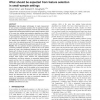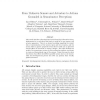1012 search results - page 29 / 203 » What Robots Can Do |
BIOINFORMATICS
2006
13 years 7 months ago
2006
Motivation: High-throughput technologies for rapid measurement of vast numbers of biological variables offer the potential for highly discriminatory diagnosis and prognosis; howev...
CCIA
2006
Springer
13 years 11 months ago
2006
Springer
In this paper, we use a massive modular architecture for the generation of complex behaviours in complex robots within the evolutionary robotics framework. We define two different ...
CONNECTION
2006
13 years 7 months ago
2006
This article describes a developmental system based on information theory implemented on a real robot that learns a model of its own sensory and actuator apparatus. There is no in...
ECSA
2010
Springer
13 years 7 months ago
2010
Springer
Security metrics are the tools for providing correct and upto-date information about a state of security. This information is essential for managing security efficiently. Although...
ATAL
2008
Springer
13 years 9 months ago
2008
Springer
In environments which possess relatively few features that enable a robot to unambiguously determine its location, global localization algorithms can result in multiple hypotheses...


